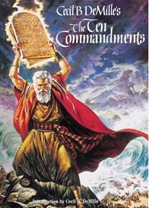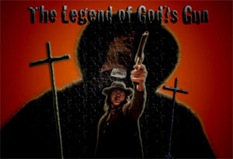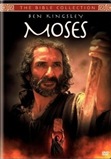Good evening Mr. & Mrs. Catholic, and all you other Christians at sea. Our year long track through Scripture continues (using The Coming Home Network’s guide to reading the Bible and the Catechism in a year), and once again we’ve run across an odd little detail in the narrative. It might fall under the radar of big blogs, but we’ve got the scoop. Now off to press.
DATELINE: EXODUS CHAPTER 4
 You know the story; you probably watch it on TV every Easter. Baby Moses gets plucked out of the Nile, grows up and flees Egypt, talks to God in the burning bush, heads back to Egypt to put the smack down on Yul Brynner, receives the Ten Commandments, and so on. But in between all those big set pieces there are brief interludes which add color to the story. Take this little transition, for instance, which occurs right after Moses has received instructions from God to return to Egypt and free the Jews. After the first day’s long journey, he and his family stop for a rest and… “At a lodging place on the way the LORD met him and sought to kill him. Then Zipporah took a flint and cut off her son's foreskin, and touched Moses' feet with it, and said, "Surely you are a bridegroom of blood to me!" So he let him alone. Then it was that she said, "You are a bridegroom of blood," because of the circumcision.” What the…!!!
You know the story; you probably watch it on TV every Easter. Baby Moses gets plucked out of the Nile, grows up and flees Egypt, talks to God in the burning bush, heads back to Egypt to put the smack down on Yul Brynner, receives the Ten Commandments, and so on. But in between all those big set pieces there are brief interludes which add color to the story. Take this little transition, for instance, which occurs right after Moses has received instructions from God to return to Egypt and free the Jews. After the first day’s long journey, he and his family stop for a rest and… “At a lodging place on the way the LORD met him and sought to kill him. Then Zipporah took a flint and cut off her son's foreskin, and touched Moses' feet with it, and said, "Surely you are a bridegroom of blood to me!" So he let him alone. Then it was that she said, "You are a bridegroom of blood," because of the circumcision.” What the…!!!
Did God just bust through a door and try to pop a cap in somebody!?! And did He really call off the hit just because Zipporah whipped out a SmartKlamp and smeared the results of the  procedure on Moses’ foot? Heck if we know. Dr. Scott M. Langston, in his book Exodus Through the Centuries, implies that an authoritative interpretation of this passage isn’t even possible because there just isn’t enough information. In fact, he seems to believe that an individual’s interpretation might be influenced more by personal baggage rather than hard facts. “The passage is enigmatic and has generated questions throughout the generations… While the original author/editor did not clearly indicate the significance of the incident, the reader’s context has profoundly influenced its interpretation.” To prove his point, the good doctor offers up pages full of differing theories from various experts across the ages, including these:
procedure on Moses’ foot? Heck if we know. Dr. Scott M. Langston, in his book Exodus Through the Centuries, implies that an authoritative interpretation of this passage isn’t even possible because there just isn’t enough information. In fact, he seems to believe that an individual’s interpretation might be influenced more by personal baggage rather than hard facts. “The passage is enigmatic and has generated questions throughout the generations… While the original author/editor did not clearly indicate the significance of the incident, the reader’s context has profoundly influenced its interpretation.” To prove his point, the good doctor offers up pages full of differing theories from various experts across the ages, including these:
A handful of rabbis in the Talmud suggest that Moses skipped circumcising his son at the prescribed time for fear the coming long journey would bring medical complications. God’s ‘attack’, however, emphasized the fact that a good Jew shouldn’t break the rules of the covenant under any circumstances.
Saint Augustine carried this argument forward to support the necessity for the baptizing of infants since, in Christian theology, baptism represents the new circumcision.
Some modern scholars have tossed around the idea that this event never happened, but is a parable used to explain how a rite once performed at puberty was transferred to infants by the Jews.
And a few really modern scholars have decided this story represents the subjugation of women by showing how the pagan Zipporah is forced by her cruel domineering husband and his male God to abandon her own beliefs and perform a man-centered Jewish ritual.
All this goes to show is that, in the absence of explicit detail, a Jew reading this passage will likely find something Jewish, a Christian will find something Christian, a secularist will try to find something  secular, and a radical feminist will find the plot to next week’s Lifetime original movie. And that’s okay, at least from the Christian’s viewpoint. As the Catechism points out, we purposely “read the Scripture within "the living Tradition of the whole Church… [Being] especially attentive "to the content and unity of the whole Scripture". Different as the books which compose it may be, Scripture is a unity by reason of the unity of God's plan, of which Christ Jesus is the center and heart.” So as long as we find some truth in our interpretation which doesn’t contradict existing dogma, we’re fine.
secular, and a radical feminist will find the plot to next week’s Lifetime original movie. And that’s okay, at least from the Christian’s viewpoint. As the Catechism points out, we purposely “read the Scripture within "the living Tradition of the whole Church… [Being] especially attentive "to the content and unity of the whole Scripture". Different as the books which compose it may be, Scripture is a unity by reason of the unity of God's plan, of which Christ Jesus is the center and heart.” So as long as we find some truth in our interpretation which doesn’t contradict existing dogma, we’re fine.
This method works even if the interpretation is kind of out there. Saint Gregory of Nyssa read this passage and somehow decided this interlude with Moses and Zipporah represented a coming together of secular philosophy and Jewish/Christian teaching where the latter “circumcised” the impurities from the former. (He’s a Saint, so we’re not going to argue.) Dr. Langston suggests that with this interpretation, odd though it is, “Gregory encourages Christians to pursue such a union, but with prudence.” As long as the proper boundaries are maintained, it can be a beneficial thing for everyone involved if Christians recognize the good to be found in non-Christian efforts while still addressing them through the lens of the Church’s viewpoint.
Some wacky Christians might even think it’s possible to do just such a thing with low budget popular entertainment. With the proper boundaries, of course.
But considering the length of this post, addressing those boundaries might best be saved for another time. For now, we close as we always do here at the Newsreel with the words of the great Les Nessman. “Good evening, and may the good news be yours.”
No comments:
Post a Comment